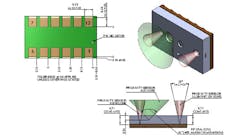A high-accuracy, optical, range-finding module developed by STMicroelectronics, based on FlightSense Time-of-Flight technology, offers designers extended distance-measurement capability. FlightSense provides accurate distance sensing by measuring the time for emitted light to reflect back from the target, whereas conventional sensors can only report reflected signal levels and not absolute distance. FlightSense technology measures longer ranges that are independent of the target reflectivity, at high frame rate and low power, compared to infrared sensors.
ST’s VL6180X module combines FlightSense proximity sensing with an ambient-light sensor (ALS) and supports basic gesture recognition. Housed in a 4.8- by 2.8- by 1.0-mm optical LGA12 package, the device can accurately measure the distance to objects at up to 100 mm or farther, subject to operating conditions. The module’s I2C interface for host control is able to read ranging or ambient light level results, and two programmable GPIO pins can be configured to implement threshold applications.
An evaluation kit combines a USB-pluggable STM32Nucleo board and VL6180X sensor shield containing the sensor, a 4-digit LED display, and a slider switch to control the ranging and ALS functions. The display shows either the distance to the target or the ambient light level.
